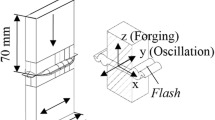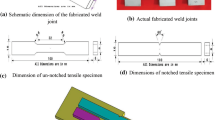Abstract
Linear friction welding (LFW) offers a new approach to manufacture aerospace components while improving the buy-to-fly ratio. However, the fundamental knowledge associated with the LFW process, including the attendant microstructural evolution and corresponding mechanical behavior is still rather limited. In this research effort, subscale tensile coupons were prepared and tested to determine the properties of each discrete zone of the linear friction welded specimen, namely the welded zone, thermomechanically affected zone, and parent material. The results show that the yield strength of the welded zone is 20 pct higher than the parent material and the thermomechanically affected zone is 13 pct higher than the parent material. Materials characterization, including optical microscopy, scanning electron microscopy, electron backscattered diffraction-based orientation microscopy and transmission electron microscopy, was conducted to develop an understanding of the microstructure–property relationships. The highly refined nature of the microstructure makes final interpretations challenging, but the evidence suggests that the mechanical behavior is dominated by phenomenon that operate at the 1 to 50 nm length scale, including strain hardening and highly refined features that hinder slip.













Similar content being viewed by others
Notes
Due to the industrial nature of this project (the work was conducted as part of an industrial consortium), the parameters for the linear friction welding properties are not available to be disclosed within this study.
This random distribution is only random in the sense that the Burgers orientation relationship is obeyed, and multiple non-random variants nucleate from the prior beta grains which may or may not have random orientations in the sample reference frame.
While this is an approximation, it is straightforward to consider a sphere of radius r that is uniaxially compressed, resulting in a compressive strain \( (\varepsilon_{z} ) \) and two in-plane elongations \( (\varepsilon_{x} ,\varepsilon_{y} ) \), from which the elongations in the respective directions can be calculated and the eccentricity of the particle determined (\( e = \sqrt {1 - \frac{{b^{2} }}{{a^{2} }}} \), where b is the compressed dimension along the z direction and a is the elongated dimension in both the x and y directions).
References
P. Wanjara, M. Jahazi: Metall. Mater. Trans. A, 2005, vol. 36(8), pp. 2149-64.
G. Buffa, D. Campanella, M. Cammalleri, A. Ducato, A. Astarita, A. Squillace, S. Esposito, L. Fratini: Procedia Manuf., 2015, vol. 1, pp. 429-41.
J. Romero, M.M. Attallah, M. Preuss, M. Karadge, S.E. Bray: Acta Mater., 2009, vol. 57(18), pp. 5582-92.
A. Vairis, M. Frost: Wear, 1998, vol. 217(1), pp. 117-31.
A. Vairis, M. Frost: Mater. Sci. Eng. A, 1999, vol. 271(1-2), pp. 477-84.
A.R. McAndrew, P.A. Colegrove, A.C. Addison, B.C.D. Flipo, M.J. Russell: Metall. Mater. Trans. A, 2014, vol. 45(13), pp. 6118-28.
A.R. McAndrew, P.A. Colegrove, C. Bühr, B.C.D. Flipo, A. Vairis: Prog. Mater. Sci., 2018, vol. 92, pp. 225-57.
I. Bhamji, M. Preuss, P.L. Threadgill, A.C. Addison: Mater. Sci. Tech., 2011, vol. 27(1), pp. 2-12.
M. Karadge, M. Preuss, C. Lovell, P.J. Withers, S. Bray: Metall. Mater. Trans. A, 2007, vol. 459(1-2), pp. 182-91.
Y. Guo, Y. Chiu, M.M. Attallah, H. Li, S. Bray, P. Bowen: J. Mater. Eng. Perform., 2012, vol. 21(5), pp. 770-6.
K. Hiroshi, N. Koji, T. Wakabayashi, N. Kenji: IHI Eng. Rev., 2014, vol. 47(1), pp. 40–43.
Y. Guo, M.M. Attallah, Y. Chiu, H. Li, S. Bray, P. Bowen: Mater. Charact., 2017, vol. 127, pp. 342-7.
W.Y. Li, T. Ma, Y. Zhang, Q. Xu, J. Li, S. Yang, H. Liao: Adv. Eng. Mater., 2008, vol. 10(1-2), pp. 89-92.
M. Grujicic, G. Arakere, B. Pandurangan, C.-F. Yen, B. Cheeseman: J. Mater. Eng. Perform., 2012, vol. 21(10), pp. 2011-23.
A.R. McAndrew, P.A. Colegrove, A.C. Addison, B.C.D. Flipo, M.J. Russell: Mater. Design, 2015, vol. 66, pp. 183-95.
W. Li, H. Wu, T. Ma, C. Yang, Z. Chen: Adv. Eng. Mater., 2012, vol. 14(5), pp. 312-8.
R. Turner, J.-C. Gebelin, R. Ward, R. Reed: Acta Mater., 2011, vol. 59(10), pp. 3792-803.
S. Chandran, P. Verleysen, J. Lian, W. Liu, S. Münstermann: Procedia Eng., 2017, vol. 197, pp. 204-13.
I. Ghamarian, Y. Liu, P. Samimi, P.C. Collins: Acta Mater., 2014, vol. 79, pp. 203-15.
G. Lütjering, J.C. Williams: Titanium, Springer, Berlin, 2007.
T. Ahmed, H. Rack: Mater. Sci. Eng. A, 1998, vol. 243(1-2), pp. 206-11.
MIPARTM, MIPAR User Manual v2.2. https://www.manula.com/manuals/mipar/user-manual/latest/en/topic/feature-measurements. Accessed 2019.
X. Gong, S. Mohan, M. Mendoza, A. Gray, P. Collins, S.R. Kalidindi: Integr. Mater. Manuf. Innov., 2017, vol. 6, pp. 218–28.
S. Balachandran, A. Kashiwar, A. Choudhury, D. Banerjee, R. Shi, Y. Wang: Acta Mater., 2016, vol. 106, pp. 374-87.
Acknowledgments
The authors acknowledge the support of the Center for Advanced Non-Ferrous Structural Alloys (CANFSA), an NSF Industry/University Cooperative Research Center (I/UCRC) between Iowa State University, and The Colorado School of Mines. The authors also acknowledge the support of the Defense Advanced Research Projects Agency (DARPA).
Author information
Authors and Affiliations
Corresponding author
Additional information
Publisher's Note
Springer Nature remains neutral with regard to jurisdictional claims in published maps and institutional affiliations.
Manuscript submitted July 13, 2020; accepted September 24, 2020.
Rights and permissions
About this article
Cite this article
Mendoza, M.Y., Quintana, M.J. & Collins, P.C. Microstructure Characterization and Mechanical Properties in Individual Zones of Linear Friction Welded Ti-6Al-4V Alloy. Metall Mater Trans A 51, 6294–6306 (2020). https://doi.org/10.1007/s11661-020-06043-1
Received:
Accepted:
Published:
Issue Date:
DOI: https://doi.org/10.1007/s11661-020-06043-1




